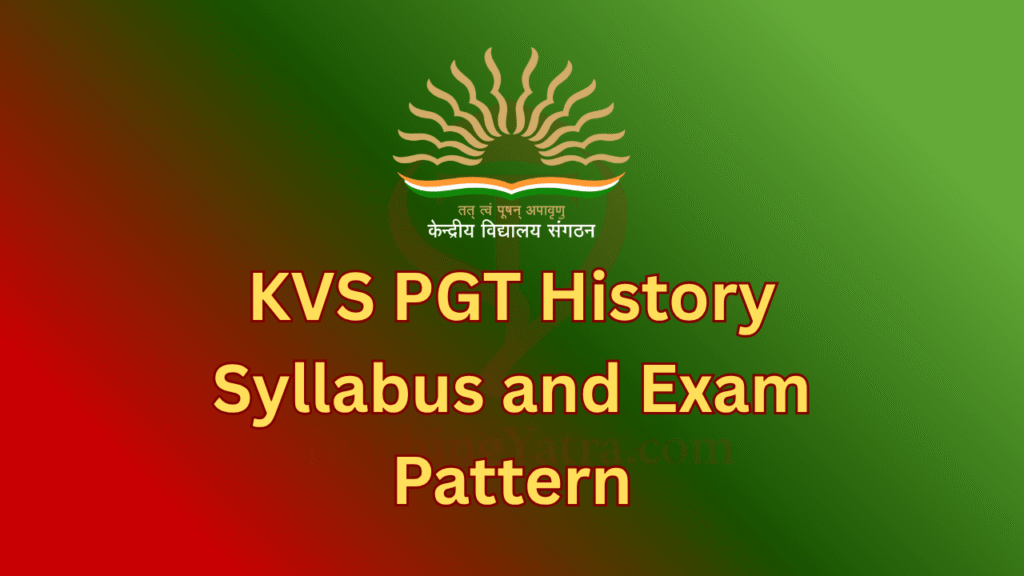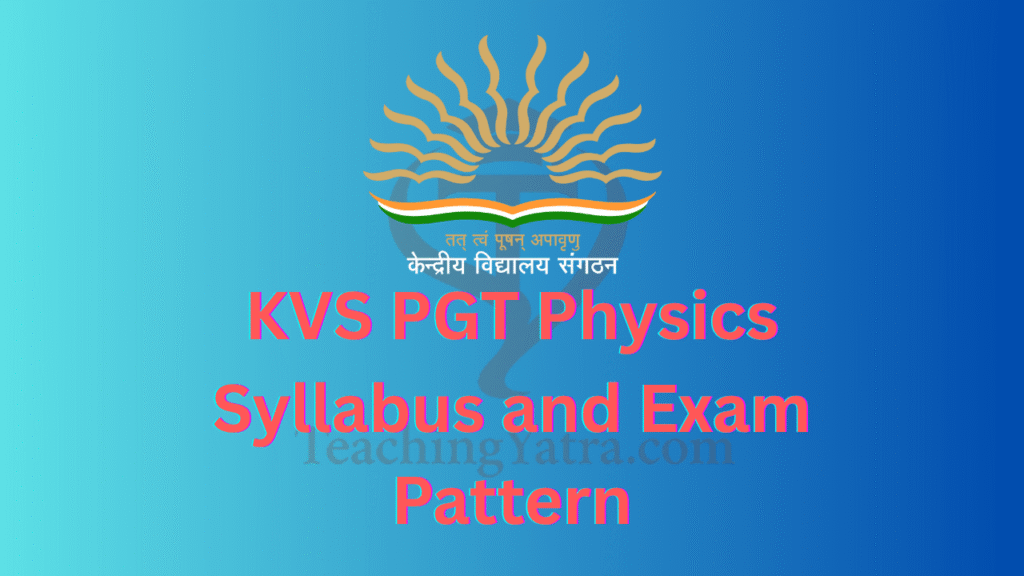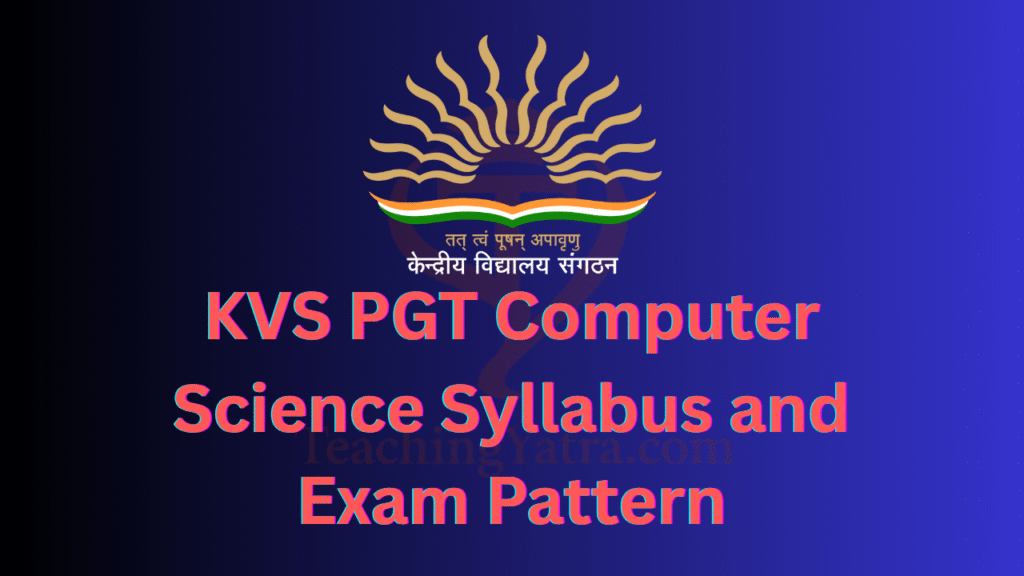
The KVS PGT History Syllabus 2025 is a vital guide for candidates preparing for the upcoming KVS PGT History Exam. Aspirants must thoroughly study and understand the syllabus to plan their preparation effectively. The detailed syllabus is available for easy access and download. Those aiming for the Post Graduate Teacher (PGT) position in History under KVS Recruitment 2025 should begin their preparation by reviewing the syllabus and downloading the PDF provided below for a structured and goal-oriented study approach.
Table of Contents
KVS PGT History Syllabus: Overview
The KVS PGT History syllabus is carefully structured to evaluate a candidate’s subject expertise, language proficiency, teaching aptitude, and overall suitability for the role of Post Graduate Teacher (PGT). A thorough understanding of the syllabus allows candidates to prepare strategically, focus on essential topics, and boost their chances of success in the examination.
The syllabus covers a comprehensive range of topics in both Indian and World History, including ancient civilizations, medieval and modern Indian history, key historical movements, and significant global events.
KVS PGT History Exam Pattern 2025
The KVS PGT History exam is divided into four parts, includes a total of 180 objective-type questions, each carrying 1 mark. The total exam duration is 3 hours (180 minutes). The paper is bilingual (English & Hindi), except for the English and Hindi sections.
| Paper | Subjects | Marks |
|---|---|---|
| Part I | General English (10), General Hindi (10) | 20 |
| Part II | General Awareness (10), Reasoning (5), Computer (5) | 20 |
| Part III | Perspectives on Education and Leadership | 40 |
| Part IV | Subject Concerned (History) | 100 |
| Total | 180 |
Detailed KVS PGT History Syllabus 2025
Subject specific syllabus includes the concepts of NCERT/CBSE syllabus and Text Books (Classes XI & XII), however, the questions will be testing the depth of understanding and application of these concepts at the level of Post- Graduation.
Writing and City Life
Iraq, 3rd millennium BCE
• Growth of towns
• Nature of early urban societies
• Historians’ debate on uses of writing
An Empire across Three Continents
Roman Empire, 27 BCE to 600 CE
• Political evolution
• Economic expansion
• Religion-culture foundation
• Late Antiquity
• Historians’ view on the institution of slavery
Nomadic Empires
The Mongols, 13th to 14th century
• The nature of nomadism
• Formation of empires
• Conquests and relations with other states
• Historians’ views on nomadic societies and state formation
The Three Orders
Western Europe, 13th to 16th century
• Feudal society and economy
• Formation of state
• Church and society
• Historians’ views on decline of feudalism
Changing Cultural Traditions
Europe, 14th to 17th century
• New ideas and new trends in literature and arts
• Relationship with earlier ideas
• The contribution of West Asia
• Historians’ viewpoint on the validity of the notion ‘European Renaissance’
Displacing Indigenous People
North America and Australia, 18th to 20th century
• European colonists in North America and Australia
• Formation of White Settler societies
• Displacement and repression of local people
• Historians’ viewpoint on the impact of European settlement on indigenous population
Paths to Modernization
East Asia, late 19th to 20th century
• Militarization and economic growth in Japan
• China and the communist alternative
• Historians’ debate on the meaning of modernization
Bricks, Beads and Bones
The Harappan Civilization
• Broad overview: Early urban centers
• Story of discovery: Harappan civilization
• Excerpt: Archaeological report on a major site
Kings, Farmers and Towns
Early States and Economies (c. 600 BCE–600 CE)
• Political and economic history from the Mauryan to the Gupta period
• Inscriptions and the decipherment of script
• Excerpt: Ashokan inscription and Gupta period land grant
Kinship, Caste and Class
Early Societies (c. 600 BCE–600 CE)
• Social histories using the Mahabharata
• Issues of caste, class, kinship, and gender
• Transmission and publication of the Mahabharata
• Excerpt: Illustrative use of the Mahabharata by historians
Thinkers, Beliefs and Buildings
Cultural Developments (c. 600 BCE–600 CE)
• History of Buddhism and other religions
• Sanchi Stupa: Discovery and significance
• Excerpt: Sculptures from Sanchi
Through the Eyes of Travellers
Perceptions of Society (10th to 17th century)
• Social and cultural life through traveller accounts
• Writings and journeys of Al-Biruni, Ibn Battuta, Francois Bernier
• Excerpts from their accounts
Bhakti – Sufi Traditions
Changes in Religious Beliefs and Devotional Texts (8th to 18th century)
• Bhakti and Sufi movements
• Transmission of Bhakti-Sufi compositions
• Excerpts from Bhakti-Sufi texts
An Imperial Capital: Vijayanagara
14th to 16th century
• Architecture: Temples, forts, irrigation in Hampi
• Relationship between architecture and political power
• Discovery and visuals of Hampi
Peasants, Zamindars and the State
Agrarian Society and the Mughal Empire (16th–17th century)
• Agrarian relations during Mughal rule
• Aini-Akbari: Compilation and translation
• Excerpt from Ain-i-Akbari
Colonialism and the Countryside
Exploring Official Archives
• Life under colonialism: Zamindars, peasants, Santhals, Paharias
• Official reports and investigations
• Excerpt: Fifth Report
Rebels and the Raj
1857 Revolt and its Representations
• Events of 1857–58
• Visions of unity and resistance
• Focus: Lucknow
• Excerpts: Pictures and contemporary accounts
Mahatma Gandhi and the Nationalist Movement
Civil Disobedience and Beyond
• Nationalist movement (1918–48)
• Gandhian politics and leadership
• Focus: Major movements and his final days
• Excerpts: Newspaper reports and writings
Framing the Constitution
The Beginning of a New Era
• Independence and formation of new nation
• Making of the Indian Constitution
• Focus: Constituent Assembly debates
• Excerpts: Selected debate transcripts
Detailed KVS PGT History Syllabus 2025 in Hindi
लेखन और नगर जीवन
इराक, तीसरी सहस्राब्दी ईसा पूर्व
• नगरों का विकास
• प्रारंभिक शहरी समाजों की प्रकृति
• लेखन के उपयोगों पर इतिहासकारों की बहस
तीन महाद्वीपों में फैला एक साम्राज्य
रोम साम्राज्य, 27 ईसा पूर्व से 600 ईस्वी तक
• राजनीतिक विकास
• आर्थिक विस्तार
• धर्म-संस्कृति की नींव
• उत्तर प्राचीन काल
• दास प्रथा पर इतिहासकारों की राय
घुमंतू साम्राज्य
मंगोल साम्राज्य, 13वीं से 14वीं शताब्दी
• घुमंतू जीवन की प्रकृति
• साम्राज्यों का निर्माण
• विजय और अन्य राज्यों से संबंध
• राज्य निर्माण और घुमंतू समाजों पर इतिहासकारों के विचार
तीन सामाजिक वर्ग
पश्चिमी यूरोप, 13वीं से 16वीं शताब्दी
• सामंती समाज और अर्थव्यवस्था
• राज्य का निर्माण
• चर्च और समाज
• सामंतवाद के पतन पर इतिहासकारों के विचार
सांस्कृतिक परंपराओं में परिवर्तन
यूरोप, 14वीं से 17वीं शताब्दी
• साहित्य और कला में नए विचार व प्रवृत्तियाँ
• पुराने विचारों से संबंध
• पश्चिम एशिया का योगदान
• ‘यूरोपीय पुनर्जागरण’ की वैधता पर इतिहासकारों की दृष्टि
स्वदेशी लोगों का विस्थापन
उत्तरी अमेरिका और ऑस्ट्रेलिया, 18वीं से 20वीं शताब्दी
• यूरोपीय उपनिवेशवादियों का आगमन
• श्वेत बसाहट समाजों का निर्माण
• स्थानीय लोगों का विस्थापन और दमन
• यूरोपीय बसाहट के प्रभाव पर इतिहासकारों की राय
आधुनिकीकरण की राहें
पूर्वी एशिया, 19वीं के अंत से 20वीं शताब्दी
• जापान में सैन्यीकरण और आर्थिक विकास
• चीन में साम्यवादी विकल्प
• आधुनिकीकरण के अर्थ पर इतिहासकारों की बहस
ईंटें, मनके और अस्थियाँ
हड़प्पा सभ्यता
• प्रारंभिक नगरीय केंद्रों का अवलोकन
• हड़प्पा सभ्यता की खोज
• प्रमुख स्थल की पुरातात्विक रिपोर्ट
राजा, किसान और नगर
प्रारंभिक राज्य और अर्थव्यवस्था (ई.पू. 600 – ई. 600)
• मौर्य से गुप्त काल तक की राजनीतिक और आर्थिक स्थिति
• शिलालेख और लिपि के पढ़ने की प्रक्रिया
• अशोक के अभिलेख और गुप्त कालीन भूमि दान
संबंध, जाति और वर्ग
प्रारंभिक समाज (ई.पू. 600 – ई. 600)
• महाभारत के माध्यम से सामाजिक इतिहास
• जाति, वर्ग, संबंध और लिंग से जुड़े मुद्दे
• महाभारत की रचना और प्रकाशन
• महाभारत के उद्धरणों से इतिहास लेखन
विचारक, विश्वास और इमारतें
सांस्कृतिक विकास (ई.पू. 600 – ई. 600)
• बौद्ध धर्म का इतिहास और अन्य धार्मिक प्रवृत्तियाँ
• साँची स्तूप की खोज और महत्त्व
• साँची की मूर्तियों के चित्र
यात्रियों की नजर से
समाज की धारणा (10वीं से 17वीं शताब्दी)
• यात्रा वृतांतों में सामाजिक व सांस्कृतिक जीवन
• यात्रा, लेखन और पाठकों की चर्चा
• अल-बिरूनी, इब्न बतूता, फ्रांस्वा बर्नियर के उद्धरण
भक्ति-सूफ़ी परंपराएँ
धार्मिक विश्वासों और भक्ति ग्रंथों में परिवर्तन (8वीं से 18वीं शताब्दी)
• भक्ति और सूफ़ी परंपराओं की रूपरेखा
• इन रचनाओं का संरक्षण और प्रसार
• भक्ति-सूफ़ी ग्रंथों से अंश
एक शाही राजधानी: विजयनगर
14वीं से 16वीं शताब्दी
• हम्पी में नई स्थापत्य कला
• इमारतों और राजनीतिक प्रणाली का संबंध
• हम्पी की खोज और चित्र
किसान, ज़मींदार और राज्य
मुगल काल की कृषि व्यवस्था (16वीं – 17वीं शताब्दी)
• मुग़ल कालीन कृषि संबंध
• आइने अकबरी का संकलन और अनुवाद
• आइने अकबरी से अंश
उपनिवेशवाद और ग्रामीण भारत
सरकारी अभिलेखों की खोज
• ज़मींदार, किसान और कारीगरों का जीवन
• स्थायी बंदोबस्त, संथाल और पहाड़िया
• सरकारी रिपोर्टों का संग्रह और उद्देश्य
• पाँचवीं रिपोर्ट से अंश
विद्रोही और राज
1857 की क्रांति और उसका चित्रण
• 1857–58 की घटनाएँ
• एकता की भावना और वर्णन
• फोकस: लखनऊ
• 1857 की तस्वीरें और समकालीन विवरण
महात्मा गांधी और राष्ट्रवादी आंदोलन
सविनय अवज्ञा और आगे
• 1918–48 का स्वतंत्रता आंदोलन
• गांधीवादी राजनीति और नेतृत्व
• तीन प्रमुख आंदोलनों और अंतिम दिन
• समकालीन अखबारों व लेखों से अंश
संविधान निर्माण
एक नए युग की शुरुआत
• स्वतंत्रता और राष्ट्र निर्माण
• संविधान निर्माण की प्रक्रिया
• संविधान सभा की बहसों पर फोकस
• बहसों से उद्धरण
Detailed KVS PGT History Syllabus 2025 PDF
| KVS PGT History Syllabus 2025 | |
| KVS PGT Syllabus 2025 (General Paper) | Click Here |
| KVS PGT History Syllabus 2025 | Click Here |

